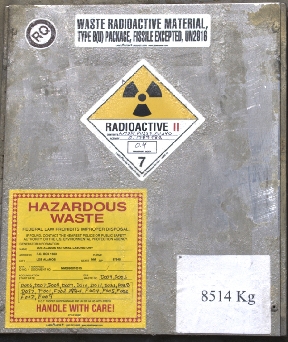For more information:
Ralph Hutchison, Oak Ridge Environmental Peace Alliance, [email protected] <mailto:[email protected]> , 865-776-5050
Marylia Kelley, Tri-Valley CAREs, Livermore, mailto:[email protected] <mailto:[email protected]> , 925-443-7148
Other key national and regional contacts are listed at the end of this release
For immediate release, August 4, 2015
HISTORIC 70TH ANNIVERSARY OF ATOMIC BOMBING OF HIROSHIMA, NAGASAKI:
Major Protests at U.S. Warhead Facilities Across the Nation Unite to Decry Trillion Dollar Plan for New U.S. Nuclear Weapons; Advocate Disarmament
A thousand or more peace advocates, Hibakusha (A-bomb survivors), religious leaders, scientists, economists, attorneys, doctors and nurses, nuclear analysts, former war planners and others across the country are coming together to commemorate the 70th Anniversary of the U.S. atomic bombings of Hiroshima and Nagasaki this August 6 through 9 at key sites in the U.S. nuclear weapons complex.
Major commemorations, rallies, protests and/or nonviolent direct actions will place at the Lawrence Livermore National Laboratory in CA, the Los Alamos National Laboratory in NM, the Kansas City Plant in MO, the Y-12 Plant in TN, the Rocky Flats Plant in CO, the Pantex Plant in TX, and in GA near the Savannah River Site. These events are united by their reflection on the past, and, uniquely, their focus on the present and future with a resolute determination to change U.S. nuclear weapons policy at the very locations that are linchpins in producing the new trillion dollar stockpile of nuclear weapons and their delivery vehicles.
“We stand on the brink of a new, global nuclear arms race,” noted Ralph Hutchison, the longstanding coordinator for the Oak Ridge Environmental Peace Alliance. “This is epitomized by government plans for a new Uranium Processing Facility to produce H-bomb components at Y-12, including for new-design weapons.”
“U.S. plans to ‘modernize’ the arsenal are also underway at Livermore Lab,” stated Marylia Kelley, Tri-Valley CAREs’ executive director. “A new Long-Range Stand Off warhead design and the start of plutonium shots in the Lab’s National Ignition Facility reveal two facets of this new arms race,” Kelley continued. “In contrast to the cold war, which was largely about sheer numbers, the new arms race and its dangers stem from novel military capabilities now being placed into nuclear weapons.”
Around the world, pressure for the U.S. to show leadership toward the abolition of nuclear weapons is growing. Pope Francis has repeatedly pressed the moral argument against nuclear weapons, inveighing not only against their use but also against their possession. In the wake of the successful Iran agreement, many are suggesting that since it has been settled that it would never be legitimate for Iran to obtain a nuclear weapon, shouldn’t we also agree that the 16,000 nuclear weapons in existence have no legitimacy either. Moreover, 113 governments recently signed the “Humanitarian Pledge,” circulated by Austria, to press the U.S. and other nuclear weapons states to fulfill their disarmament obligations.
Actions this week at U.S. nuclear weapons facilities will highlight the mounting international calls for nuclear abolition, with U.S. organizers lending their deep and often unique “on the ground” knowledge from the gates and fence lines of the facilities involved in creating new and modified U.S. nuclear weapons. “This 70th anniversary should be a time to reflect on the absolute horror of a nuclear detonation,” mused Ann Suellentrop of Physicians for Social Responsibility-Kansas City, “yet the new Kansas City Plant is churning out components to extend U.S. nuclear weapons 70 years into the future. The imperative to change that future is what motivates me to organize a peace fast at the gates of the Plant.”
Key events at U.S. nuclear weapons complex sites include:
• Y-12 – pastoral letter, remembrance, rally and nonviolent direct action, peace fast and lanterns. (More at http://orepa.org/action/hiroshimanagasaki-70/ <http://orepa.org/action/hiroshimanagasaki-70/> )
• Livermore Lab – peace camp, August 6 rally and nonviolent direct action, peace fast at the gates. (More info at www.trivalleycares.org <http://www.trivalleycares.org> )
• Los Alamos Lab – film screening, panels, rally and conference (More at www.nuclearwatch.org <http://www.nuclearwatch.org> )
• Kansas City Plant – atomic photographers exhibit, speakers, film screening, and peace fast at the gates. (More info at www.psr.org/chapters/kansas/ <http://www.psr.org/chapters/kansas/> )
• Savannah River Site – film screening, vigil, and circle of hope. (More: www.nonukesyall.org <http://www.nonukesyall.org> )
• Rocky Flats Plant – peace quilt, concert, film screening, labyrinth mourning walk. (More from [email protected] <mailto:[email protected]> )
• Pantex Plant – Hiroshima exhibit, panel discussion. (More at: www.peacefarm.us <http://www.peacefarm.us> )
These and other Hiroshima events and actions at sites in the U.S. nuclear weapons complex are being led by organizations that are members of the Alliance for Nuclear Accountability, which represents about three dozen groups. More about ANA can be found at www.ananuclear.org <http://www.ananuclear.org> .
ANA contacts available for interviews include:
Joni Arends, Concerned Citizens for Nuclear Safety, [email protected] <mailto:[email protected]> , 505 986-1973 (NM sites)
Jay Coghlan, Nuclear Watch New Mexico, [email protected] <mailto:[email protected]> , 505-989-7342 (NM sites)
Ann Suellentrop, Physicians for Social Responsibility-KC, [email protected] <mailto:[email protected]> , 913-271-7925 (MO site)
Kevin Kamps, Beyond Nuclear, [email protected] <mailto:[email protected]> , 240-462-3216 (Ohio sites)
Jerry Stein, Peace Farm, [email protected] <mailto:[email protected]> , 806-351-2744 (TX site)
Judith Mohling, Rocky Mountain Peace & Justice Center, [email protected] <mailto:[email protected]> , 303-447-9635 (CO sites)
Glenn Carroll, Nuclear Watch South, [email protected] <mailto:[email protected]> , 404-378-4263 (SC, GA sites)
Paul Kawika Martin, Peace Action, [email protected] <mailto:[email protected]> , 951-217-7285 (in Hiroshima)
Ralph Hutchison, Oak Ridge Environmental Peace Alliance, [email protected] <mailto:[email protected]> , 865-776-5050 (TN sites)
Marylia Kelley, Tri-Valley CAREs. [email protected] <mailto:[email protected]> , 925-443-7148 (CA sites)
Jackie Cabasso, Western States Legal Foundation, United for Peace & Justice, [email protected] <mailto:[email protected]> , 510-839-5877 (CA sites, calendar of national events)
Additional resources for media:
Physicians for Social Responsibility calendar and map of Hiroshima and Nagasaki actions at: www.psr.org/news-events/events/hiroshimadayevents-2015.html <http://www.psr.org/news-events/events/hiroshimadayevents-2015.html>
United for Peace and Justice, Nuclear Free Future Month calendar of events at: www.nuclearfreefuture.org <http://www.nuclearfreefuture.org>
###












